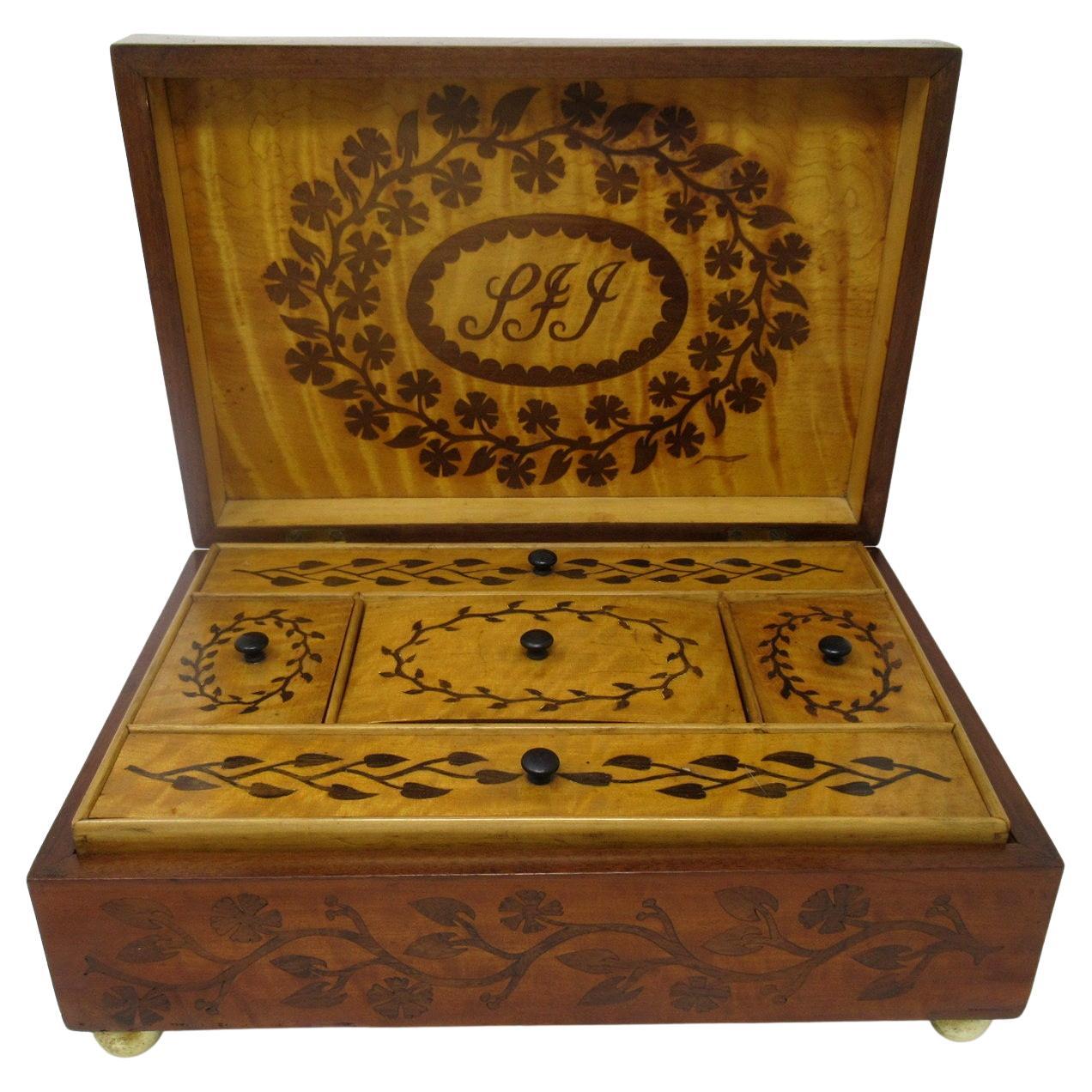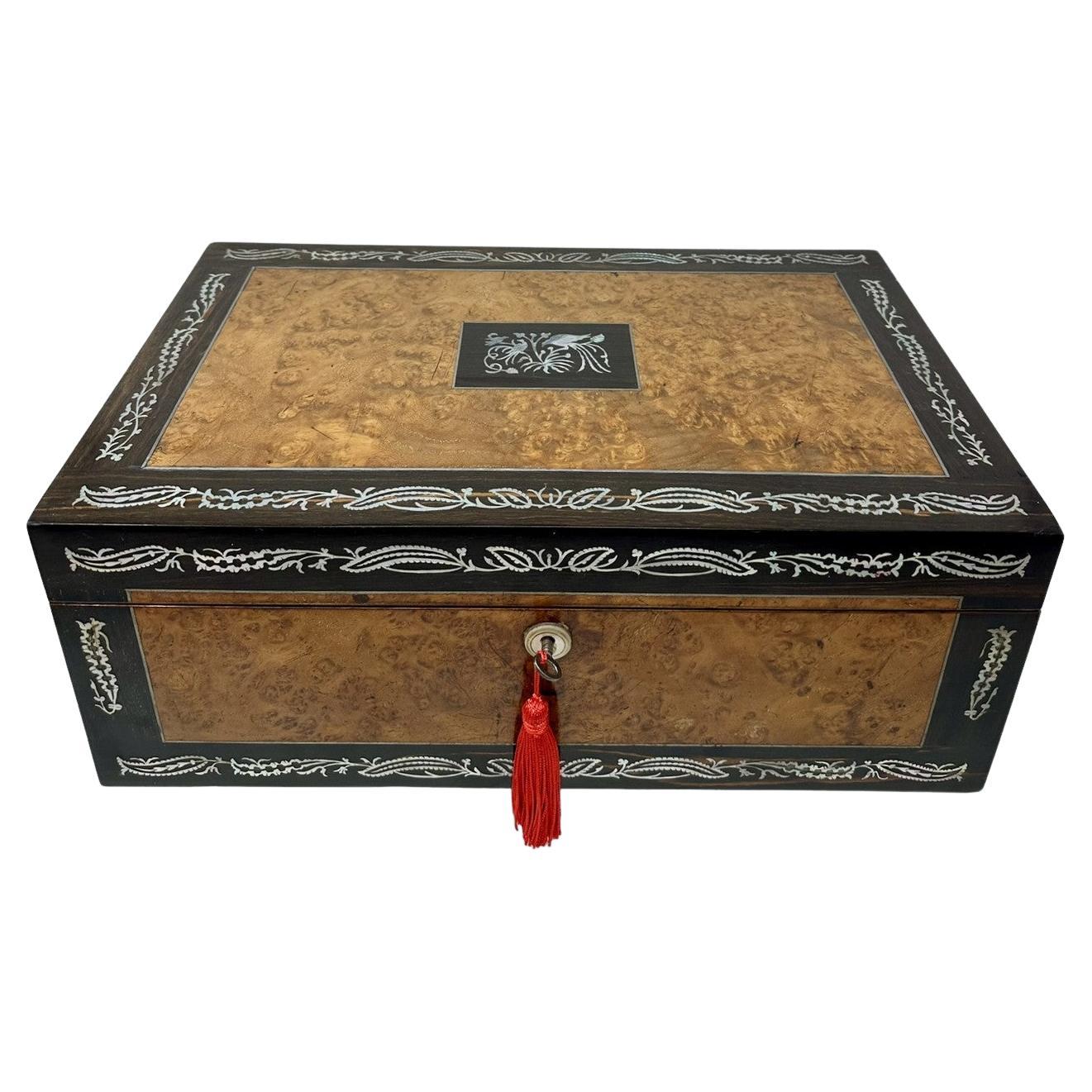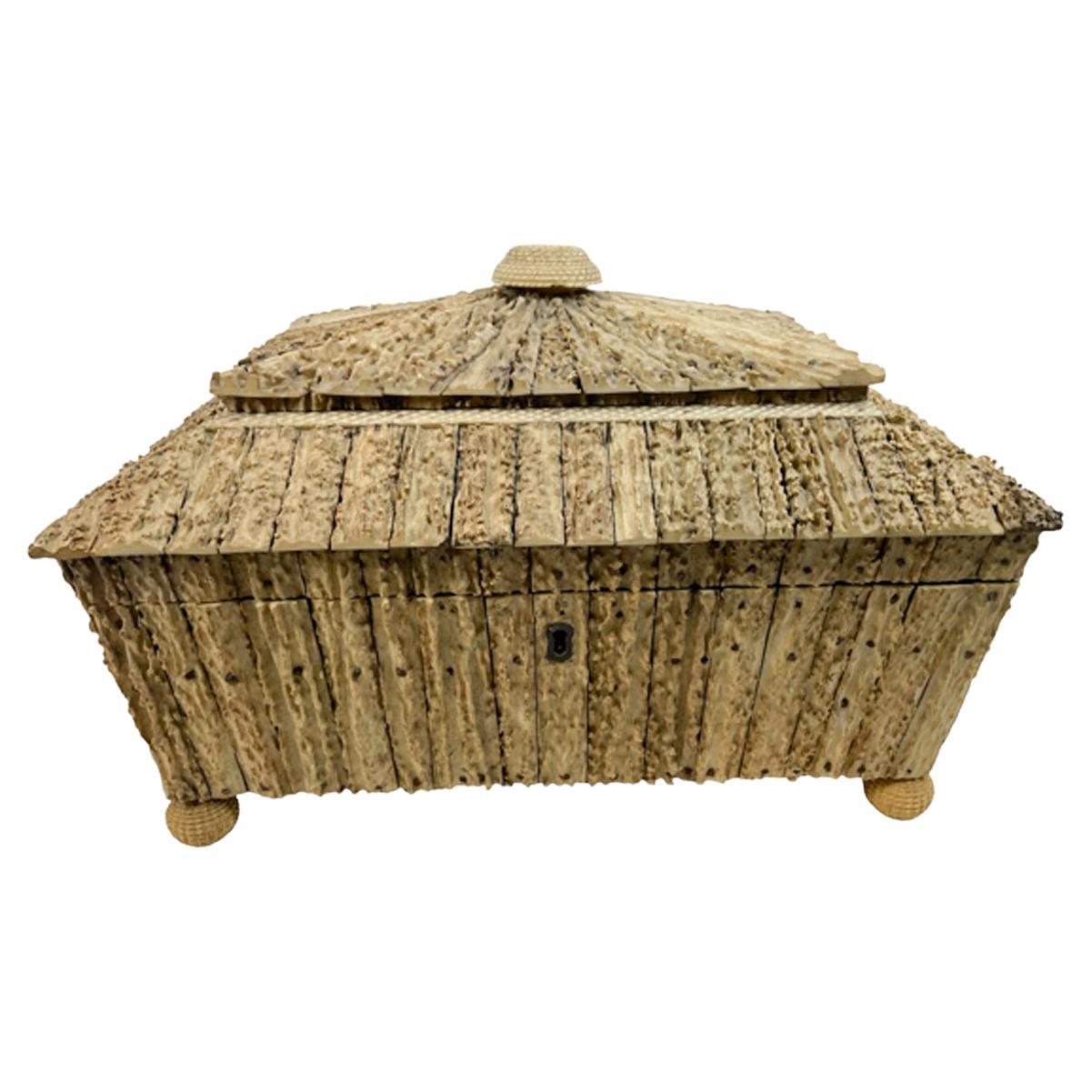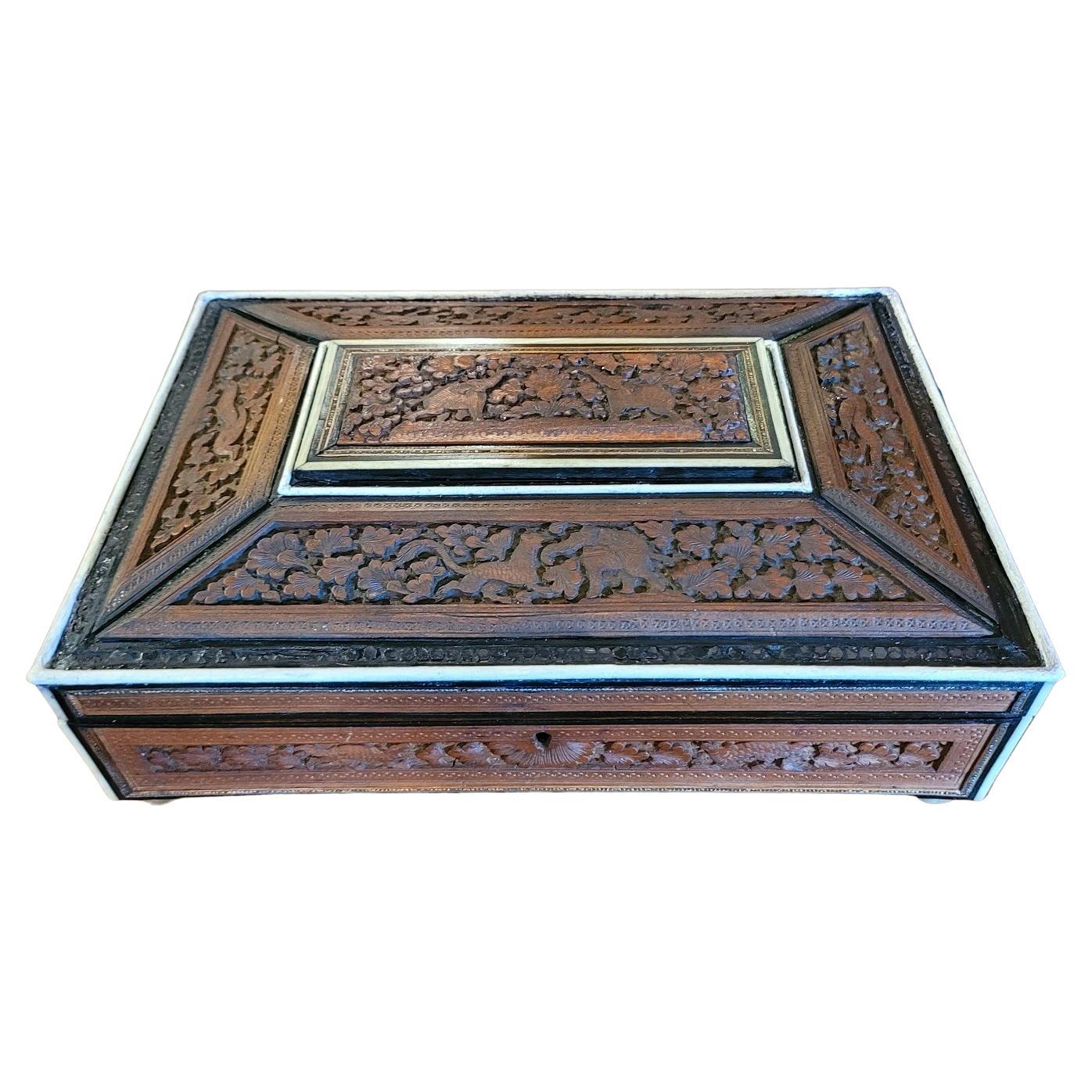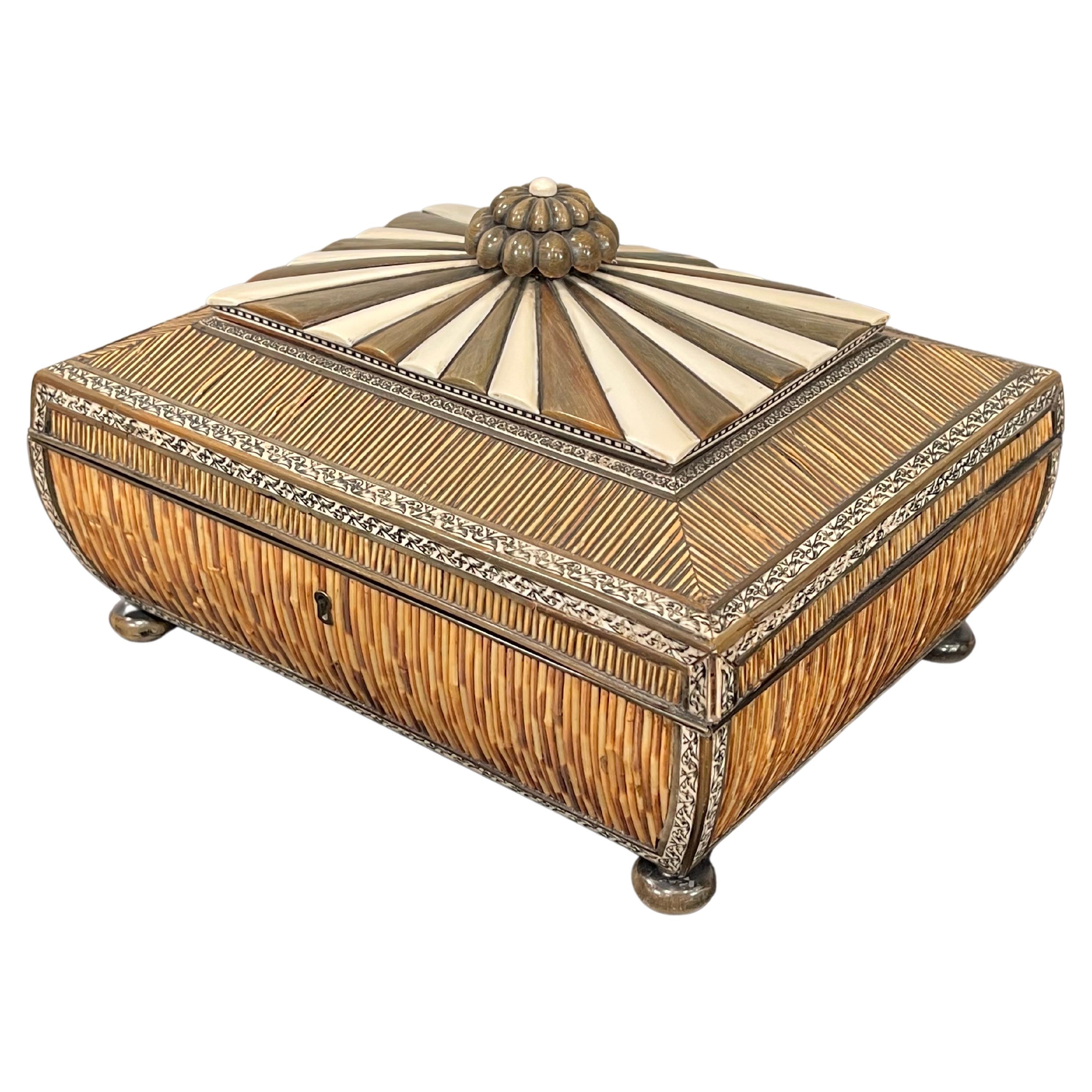Items Similar to Antique Anglo Indian Coromandel Satinwood Lady, SJewellery Sewing Table Box 19ct
Want more images or videos?
Request additional images or videos from the seller
1 of 10
Antique Anglo Indian Coromandel Satinwood Lady, SJewellery Sewing Table Box 19ct
About the Item
Stunning and Rare Example of a well grained Ladys or Gentlemans Coromandle Anglo Indian, possibly Ceylonese, fitted Travelling Sewing or Jewellery Casket of good size proportions. Third quarter of the Nineteenth Century.
The rectangular hinged lidded box opening to reveal a large amount of fitted lidded compartments, with stunning decorative covers using fruit woods and other decorative materials, the entire outer main area constructed with lavish grained Coromandel. The front complete with lower full width and depth pull out lockable drawer
Condition: Good condition, original good surface patination. Locks are present, single key opens both locks. Two inside covers are missing, see image.
Measures: height: 5.25" (13.5cm). width: (an impressive) 16" (41cm). depth: 11.25" (28.5cm).
Location: Dublin City, Ireland.
Affordable Fixed charge Worldwide Store to door shipping.
Coromandel: also known as Makassar Ebony, is a member of the genus Diospyros and one of the plants commonly known as ebony. Coromandel ebony wood is variegated, streaky brown and black, nearly always wide striped. It is considered a highly valuable wood for turnery, fine cabinet work and joinery.
The tree grows up to 20 meters under favourable circumstances, although such trees are rarely seen nowadays. Since Coromandel ebony has been a woodworker's favorite for centuries, most of it has been felled and used in high quality furniture. The natural area of distribution are some Indonesian islands.As this exceptionally beautiful species of the Ebonies has been much appreciated by woodworkers all over the world through the past 2 centuries it has now become a very scarce and expensive timber. The small available amounts on the market have led to very high prices, Makassar ebony nowadays belongs to the highest priced timbers on the world, the region of growth is quite restricted.
- Dimensions:Height: 5.25 in (13.34 cm)Width: 16 in (40.64 cm)Depth: 11.25 in (28.58 cm)
- Style:Victorian (Of the Period)
- Materials and Techniques:
- Place of Origin:
- Period:
- Date of Manufacture:circa 1850
- Condition:Please read full Condition Report within the listing.
- Seller Location:Dublin, IE
- Reference Number:1stDibs: LU5035231362452
About the Seller
5.0
Platinum Seller
These expertly vetted sellers are 1stDibs' most experienced sellers and are rated highest by our customers.
Established in 1992
1stDibs seller since 2019
190 sales on 1stDibs
Typical response time: <1 hour
- ShippingRetrieving quote...Ships From: Dublin, Ireland
- Return PolicyA return for this item may be initiated within 7 days of delivery.
More From This SellerView All
- Antique Gentleman's Satinwood Mahogany Marquetry Jewellery Casket Table Box 19ctLocated in Dublin, IrelandAn exceptionally fine well figured Satinwood Marquetry Ladies or Gentlemans Jewellery Casket of outstanding quality and condition, last quarter of th...Category
Antique 19th Century English Edwardian Jewelry Boxes
MaterialsBrass
- Antique Pewter Inlaid Burl Amboyne Coromandel Desk Wooden Writing Slope Box 19CtLocated in Dublin, IrelandAn Exceptionally Fine Quality English Well Figured Burl Amboyne and Coromandel Ladies or Gents English early Travelling Writing Slope of outstanding quality and unusually large propo...Category
Antique 19th Century English Georgian Desks
MaterialsBrass
- Antique French Brass Inlaid Mahogany Writing Slope Box 19CtBy André-Charles BoulleLocated in Dublin, IrelandAn exceptionally fine quality example of a polished brass inlaid travelling writing slope made during the third quarter of the 19th century, of French origin. The entire top area d...Category
Antique 19th Century French Victorian Desks and Writing Tables
MaterialsBrass
- Antique Victorian Brass Inlaid Mahogany French Double Tea Caddy Box Casket 19ctLocated in Dublin, IrelandA superb example of a French well figured brass inlaid Rosewood, late Victorian period double interior section tea caddy of flat rectangular outline, generous proportions and outstanding quality, all areas are edged with self-quadrant mouldings, complete with original lock and key. Last quarter of the 19th century. The hinged cover opens to reveal an original fitted interior of twin smooth lift out finial covers. Condition: superb condition with no losses to inlays, interior foil linings are quite worn. Baise underneath has wonderful age-wear, very nice untouched surface patination. Lock is present and working, key supplied does not turn mechanism. Measures: height: (overall as shown) 4.75” (12cm). Width: 9.25” (23.5cm). Depth: 4.75” (12cm). Location: Dublin City, Ireland. Affordable fixed charge Worldwide Store to door shipping offered...Category
Antique 19th Century French Victorian Tea Caddies
MaterialsBrass
- Antique Victorian Brass Burl Walnut Traveling Desk Wooden Writing Slope Box 19ctLocated in Dublin, IrelandAn Exceptionally fine Quality English Well Figured Solid Burr Walnut Ladies or Gents Travelling Writing Slope of outstanding quality and quite large proportions. Third quarter of the...Category
Antique 19th Century English Victorian Inkwells
MaterialsBrass
- Antique Irish Coromandel Satinwood Writing Slope Box by Austins Dublin IrelandLocated in Dublin, IrelandStunning and Rare Example of an Irish well grained Ladys or Gentlemans Coromandel Travelling Writing Slope of good size proportions, made in Dublin, Ireland by George Austin. Third q...Category
Antique 19th Century Irish Victorian Desks and Writing Tables
MaterialsMahogany, Satinwood
You May Also Like
- 19th Century Anglo-Indian Vizagapatam Antler Veneered Sewing / Work BoxLocated in Chapel Hill, NCA fine Vizagapatam made antler veneered sewing / work box having tapered sides and a double tiered four-slope lid with a carved finial and all raised on four turned feet. The interio...Category
Antique Mid-19th Century Indian Anglo-Indian Decorative Boxes
MaterialsAntler, Wood
- 19c Anglo Indian Highly Carved Padouk and Sandalwood Sarcophagus Sewing BoxLocated in Dallas, TXPRESENTING A VERY NICE 19C Anglo Indian Highly Carved Padouk and Sandalwood Sarcophagus Sewing Box. Made in Bombay, India circa 1890-1900. The box case/body is made of sandalwo...Category
Antique Late 19th Century Indian Anglo-Indian Decorative Boxes
MaterialsBone, Padouk, Sandalwood
- Regency Anglo Indian Quill Work Vizagapatam Sandalwood Sewing BoxLocated in New York, NYThis fine Regency period quill work, bone, ivory & sandalwood sewing box with intact interior w sewing implements.Category
Antique Early 19th Century Indian Regency Decorative Boxes
MaterialsBone, Sandalwood, Ivory
- Anglo Indian BoxLocated in Tampa, FL19th century Anglo Indian box with raised painted arches on front, fantastic with a lot of patina. Does not have a key has small button feet.Category
Antique 1880s English Decorative Boxes
MaterialsWood, Paint
- Anglo-Indian Stag Horn Veneered Sewing / Work Box From VizagapatamLocated in Chapel Hill, NCAnglo-Indian stag horn veneered sandalwood sewing or work box with a sloped two-tier lid having a carved finial above tapered sides and raised on compressed ball feet. The interior w...Category
Antique Mid-19th Century Indian Anglo Raj Decorative Boxes
MaterialsBone, Antler, Wood
- 19C Anglo Indian Vizigapatam Stamp BoxLocated in Dallas, TXPresenting an absolutely gorgeous and very rare 19C Anglo Indian Vizigapatam stamp box. Made in Colonial India (the Time of the Raj) circa 1860. Prob...Category
Antique Mid-19th Century Indian Anglo-Indian Decorative Boxes
MaterialsBone, Shell
Recently Viewed
View AllMore Ways To Browse
High Quality Antique Furniture
Fine Jewelry Box
Fine Jewelry Boxes
Large Black Box
Antique Box Table
Jewelry Box With Lock
Box With Smaller Box Inside
Victorian Jewlery Boxes
Victorian Jewellery Box
Victorian Jewelry Box
Grain Box
Small Locking Box
Antique Victorian Jewelry Boxes
Antique Jewelry Box Victorian
Victorian Antique Jewelry Box
Antique Victorian Jewellery Box
Antique Victorian Jewelry Box
Beautiful Antique Jewellery Box
